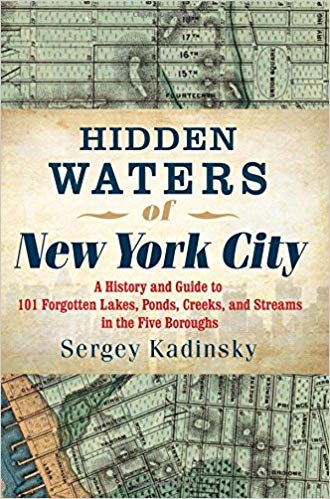The following was originally published over at Hidden Waters Blog, a companion blog to the amazing Hidden Waters of NYC book by Sergey Kadinsky, and reprinted with permission.
Near the northern border of Woodlawn Cemetery in the Bronx is a natural lake that shares its name with the cemetery and the surrounding neighborhood. It is a pleasant feature in the park-like graveyard that contains the remains and monuments for some of New York’s most famous people.

This water feature and the cemetery itself are contemporaries of Brooklyn’s Green-Wood and Evergreens cemeteries, which also have the appearances of a “burial park.” And like any distinguished park, they preserved their ponds while the surrounding landscape filled up with bodies and monuments.
Where it Flows

As seen on the 1868 Frederick W. Beers map of the cemetery, Woodlawn Lake is located in a ravine on the knob-and-kettle terrain formed by the most recent ice age. When the lake overflowed, a brook carried the water out of the cemetery into the Bronx River. The cemetery had opened a decade prior to this map and contained another four ponds within its borders.

An 1893 map from the NYPL collection shows the brook partially filled, while another pond on the cemetery’s northeast corner still there, but not for long. A 1912 map shows the brook and the pond at Sylvan Dell Plot both gone. With the amount of available land shrinking as more bodies filled the property, the other waterways were covered, leaving Woodlawn Lake as the only remaining water feature, minus its brook.

A more recent map shows the lake in a necropolis where every road and block has a name. The layout of these roads is reminiscent of Central Park and Forest Hills Gardens, with gentle curves that respect the topography as opposed to a rectilinear grid. Lake Avenue borders the waterway and follows the course of its filled-in brook, while Spruce Avenue crosses the lake atop a stone arch bridge. Among the famous locals buried near its shores is George Lorillard, whose property later became the New York Botanical Garden, a mile to the south on the Bronx River. In 2014, one cemetery visitor foolishly walked atop the frozen lake and nearly drowned. A cemetery waterway wouldn’t be complete without its own tragic story!

The wealth of the cemetery’s interred is shown in the elaborate tombs and grave markers ringing the lake. But in more recent years with the rise in cremations, a simple urn, niche, or sprinkling of the ashes in a sentimental location suffices in preserving the physical memory of the departed. I don’t see much value in building “palaces” where nobody is expected to live, and how many great-great-great-great grandchildren take time to visit the mausoleums of their distinguished ancestors? As we are all equal in death, a simple gravestone not only demonstrates equality but also leaves space for others to be buried.

Certainly I don’t wish to see Woodlawn transformed into a crowded cemetery that leaves no space for grass, trees, benches, and a lake. I also recognize that many of the monuments serve as architectural landmarks and tour attractions, veritable works of art from some of the most famous architects of their time. The presence of Woodlawn Lake helps retain a natural appearance to the cemetery with an eternal and calming item, water, in a place where our temporary presence on earth is put to rest. It is an ideal waterway to visit in time for Halloween, All Souls Day, and fall foliage.
If you wish to learn more about lakes in cemeteries, read my page about Maple Grove Cemetery and Delta Lake in Queens., and Moravian Cemetery on Staten Island. The beauty and popularity of Woodlawn Cemetery resulted in subsequent cemeteries with the same name operating in Detroit, Washington, Elmira, Canandaigua, West Palm Beach, Las Vegas, Toledo, and Saskatoon. Did I leave out another town? All have their share of famous burials, monuments, and some have their own natural water features.
About the Author
Sergey Kadinsky is the author of Hidden Waters of New York City: A History and Guide to 101 Forgotten Lakes, Ponds, Creeks, and Streams in the Five Boroughs (2016, Countryman Press) and the webmaster of Hidden Waters Blog.
Kadinsky is an analyst at the New York City Department of Parks & Recreation and an adjunct professor of history at Touro College.
He is a licensed tour guide who paid his way through college atop the double-decker Gray Line buses.
He is also contributor to Forgotten New York, a local history website. His articles on the city’s history appeared in New York Post, New York Daily News, and Queens Chronicle, among other publications.



